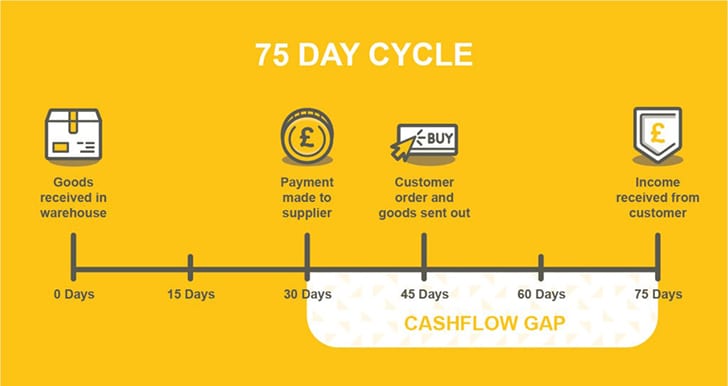
Generally speaking, when it comes to future expectations of their profit and loss, business owners tend to know their business inside and out. They know what margin they will make on each product or service, and have a good understanding of their overheads.
What business owners do not necessarily know inside and out, is how and when changes (however small) to sales, purchases and other general business costs will affect their bank balance. The phrase ‘turnover is vanity, profit is sanity and cash is king’ has never been so relevant. .
Why is cashflow forecasting important?
It’s important to recognise that a company’s profit at the end of a given month, does not mean that the company has this much cash coming into the business.
Without forecasting a company’s cashflow, it would be very difficult to estimate how much cash your company will have at a given time. Likewise, if you add to this wages, payroll taxes, VAT, corporation tax payments and loan repayments, the situation can become even more complicated!
It is now more important than ever to be understanding cash movements within your business. Do you have staff on furlough? When the furlough period ends, will your business be able to afford to retain its current staffing levels? Has your business deferred VAT? What cash position will your business likely be in when it becomes time to repay this liability? These are the types of considerations that businesses need to be assessing now, rather than when it is too late.
A simple example of why cashflow forecasting is important

- A Company sells Product A.
- They have to purchase Product A from their supplier, and tend to have stock on hand for 45 days before it is sold.
- They are given a 30-day credit period from their suppliers, and they also offer their customers a 30-day credit period.
- Based on the diagram, there is a gap of approximately 45 days between having to pay for a product, and receiving the income from their customer.
- If this company were to sell multiple other products, all of which had varying lead times, how can the company know how much cash they will have available at any time?
Many businesses that go through tremendous growth, can often find themselves unable to fulfil orders due to a lack of cash and resource available. By plotting out the expected cash movements of each element of your business, it will allow you to plan for the future. In our experience, the best performing businesses use a cashflow forecast as a strategic tool.
What is three-way forecasting?
The term ‘three-way forecasting’ refers to the ability to forecast your profit, balance sheet and cashflow altogether, as these are all integrated.
As stated, it is important to understand that not all of the income and costs of a company go through the profit and loss, some aspects of a business’s also affect the company’s balance sheet – for example:
- Income from finance
- Capital purchases
- Capital repayments
- Other types of finance
- Prepayments
- Accruals
- VAT movements and deferrals
- HMRC time to pay arrangements that may have recently been made
Each of these represent a significant receipt or payment of the company. Why is this important? Without three-way forecasting in place, any one or all of these payments could be missed and would likely cause extreme pressure on cashflow.
Is there a benefit to tracking your businesses forecasts against actual results?
Some people think that there is no benefit of comparing actuals against budgets, as it has already happened and there is nothing that can be done about it.
In fact, it is quite the opposite. By comparing forecasts to actuals, businesses will gain a better understanding of why they are not hitting certain targets or overspending in certain areas. This will empower businesses to implement changes and create efficiencies.
The types of questions this review may raise are:
- If sales were not achieved in a given month, why was this?
- Is there a certain customer who is buying less from us now, why?
- What can we do to improve this relationship, so they don’t go elsewhere?
- Our gross profit margin is less than expected, why was this?
- Is there a certain supplier that has increased their costs?
- How much resource is used for this product/supply, is it still a profitable product?
5 tips when creating your three-way forecast
- Compare your budget to recent actual results.
-
- Does this budget look realistic, or unachievable?
- Are you missing any major costs or income?
- Do not forget about expenditure that you may not see on your profit and loss – these may include:
-
- Capital purchases
- Loans
- Capital repayments
- Other types of finance
- Prepayments
- Accruals
- VAT movements
- Think about your assumptions carefully, do not use a broad brush approach as most businesses are not that simple:
-
- Is 20% VAT applied to all purchases and all sales? If this is not the case then it is not appropriate to apply this assumption.
- Are all debtors on sales received within 30 days? Whilst this may be the credit terms that are given to customers, is this truly how they pay us? Consider reviewing terms with certain suppliers.
4 . Review your forecast balance sheet over a period of time and check each line carefully, do the figures start to look very unrealistic in a short space of time?
-
- Have trade debtors increased by 20%, but sales have only increased by 5%? This suggests the assumptions used were not based on reality.
- Always compare your budgets with actuals on a line by line basis in a timely manner. This will ensure you are picking up any issues with spending and income and can address them accordingly.
If you are unsure how to generate a cashflow forecast, contact Menzies’ Forecasting Specialist, Sadie Channing at [email protected].


























